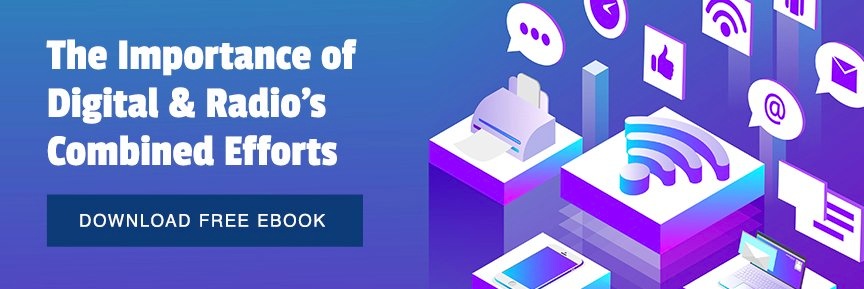Radio advertising is a time-honored means of spreading brand awareness and acquiring new customers. In today's Digital Age, it is usually most effective when combined with other marketing tactics. The following discusses 5 such tactics that can boost the ROI from your radio ads and help you to grow your business.
Streaming Ads
Many radio stations stream their signals so that listeners can access the audio through the station website, apps, skills on home speaker devices (like Alexa and Google Home), and aggregating apps like TuneIn or iHeart.
The advantage of streaming ads is that the radio stations are usually not simulcast. That means that each listener will hear a different ad depending on their device, gender, age, household income, and other demographics. Streaming ads are sold by impressions instead of “spots” like ordinary radio. In this way, streaming ads are like radio ads with the targeting power of digital ads.
Podcasts
The podcasting industry has exploded in popularity over the past several years, and many radio broadcasters are taking advantage of this trend. Afterall, radio broadcast professionals are experts in audio, now they’re transitioning their passion for a particular subject into quality podcasts that advertisers can take advantage of. The interactions between radio ads and podcasts can ultimately produce better outcomes for both marketing channels. For instance:
- Podcast followers tend to be exceptionally loyal to a favorite host. Advertisers can take advantage of this by developing "host-read ads" that features a host from a popular podcast. Such ads are exceptional drivers for engagement and listener follow-through.
- Companies can also pay for pre-roll and mid-roll ads in a podcast that many of their target consumers enjoy. This allows for the adaptation of a radio-style ad for distribution over a podcast instead.
- Advertisers can also look into options like branded podcasts or exclusive podcast sponsorships.
Around 38% of podcast listeners tune in to their favorite podcast on a daily or almost-daily basis, while 66% of them listen weekly. With such statistics in mind, it's clear that radio and podcast advertising can "feed off" of each other and contribute to an exceptional return on ad spend.
Retargeting
Retargeting techniques allow companies to deliver ads to a specific subset of consumers. Visitors who arrive at a certain landing page can be tracked across the Internet by a "pixel." This in turn enables the highest bidder on a programmatic ad network to display its ads to those consumers as they browse across other sites.
With an average click-through rate that is 10 times higher than that of non-targeted ads, retargeting can be a highly effective marketing tactic, and radio ads can enhance this strategy's impact. For example, an ad's call to action may direct listeners to a specific landing page with a pixel, thus enabling the company to segment its retargeting ad strategy according to radio listeners vs. users of other mediums.
Social Media
Radio hosts and DJs often have strong ties to the local community with many listeners seeing them as trusted friends. In fact, one survey of radio personalities found that 62% think AM/FM radio will hold its position in the next five years, and 10% think it will grow.
At the same time, radio influencers and stations are exploring ways to use social media for expanded reach. More and more consumers spend the bulk of their free time on social media platforms.
Many DJs regularly post to social media and have developed loyal audiences on their own accounts. Businesses can partner with radio hosts for social media influencer campaigns, where the DJ will endorse a relevant product or brand both on air and on their own social media accounts. This powerful tactic expands the reach of the ever-popular on-air endorsement campaign.
Businesses can also partner with radio stations for contests and giveaways that may be promoted on a station’s social media accounts. For example, getting involved in a popular radio station’s annual holiday promotion can be an effective way to grow brand recognition and stand out from other ads during a busy shopping season.
Integration Works
Some 36% of marketers are attempting to integrate traditional and digital marketing activities. With that in mind, it should come as no shock that hybrid strategies involving radio and search engine marketing are becoming increasingly popular in the marketing world. Moreover, such strategies are associated with industry-leading results. For instance, one study found that a radio + digital mix resulted in a 23% uplift in sales, outperforming TV + digital, digital alone, radio alone, and TV alone. Imagine if you’re running a radio campaign and your website can’t be found online. That’s where radio and digital deliver powerful results.
For instance, a radio ad can drive traffic to a page on the website which has a retargeting pixel. This way, the listener will be repeatedly exposed to both radio and digital ads regardless of the findability of the website itself.
The key to success is effective integration. Digital and radio touchpoints must work together to move interested prospects down the sales funnel.
The above four marketing tactics, when properly integrated with radio ads, will result in a greater impact and superior ROI compared to traditional or digital channels by themselves. With some forethought and sound execution, you can leverage such tactics to achieve sustainable growth for your brand for years to come.

